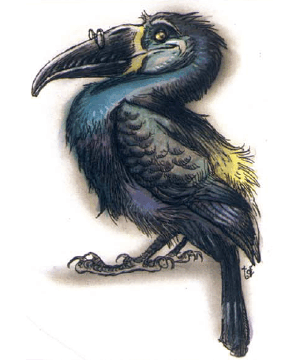

2145

| Climate/Terrain: | Any land |
|---|---|
| Frequency: | Very rare |
| Organization: | Solitary |
| Activity Cycle: | Any |
| Diet: | Omnivore |
| Intelligence: | Genius (17-18) |
| Treasure: | U |
| Alignment: | Neutral |
| No. Appearing: | 1 |
| Armor Class: | 6 |
| Movement: | 6, Fl 18 (C) |
| Hit Dice: | 5 |
| THAC0: | 15 |
| No. of Attacks: | 1 |
| Damage/Attack: | 1d8 |
| Special Attacks: | Nil |
| Special Defenses: | Nil |
| Magic Resistance: | 50% |
| Size: | S (2� tall, 4� wingspan) |
| Morale: | Unsteady (5-7) |
| XP Value: | 1,400 |
The talking bird is large-billed and looks something like a toucan crossed with a parrot.
These creatures speak Common and learn to speak many other languages during their lives; there is a 75% chance they can speak any particular language. Their speaking voice is calm and melodious. Their singing voice is also very beautiful, and it attracts other singing birds to the area so they might join in chorus with the talking bird.
Combat: Talking birds avoid combat, usually by flying away, though they can defend themselves, and they do attack small animals for food. The sharp bill of a talking bird inflicts 1d8 points of damage.
Habitat/Society: These intelligent birds have very long life spans, which they spend gathering knowledge about the world. They sometimes offer wise advice to weary travelers, and they know instantly if someone has honor. If approached politely by such a person, they answer all manner of questions. A talking bird has knowledge equivalent to that afforded by the local history nonweapon proficiency; many of them have ancient history and other Intelligence-based proficiencies as well.
Legends hold that the first talking bird was placed in the world to help the worthy. Now, though they are still quite rare, there are several talking birds. They can be found almost anywhere, but prefer to live in forested areas, and many seem to be assigned by unknown forces to wait in certain places.
Some of them wait to give advice to any who pass through the area, while others wait for a specific person who will take them away. A few serve as wise advisors and teachers to honorable and deserving people; for these chosen few, the talking bird answers many questions indeed. One question never answered by a talking bird is, �What do the gods have in store for me?� This question and its many variations are invariably answered with, �Only the gods know for sure�.
On the rare occasions when a male and a female talking bird meet (perhaps once every 50 years), they go through an elaborate mating dance that lasts for up to one week. The female then lays a single egg, one year after mating, which hatches almost five years later. Newly hatched talking birds are as beautiful as their parents, but must be taught like all infants. They are usually taught new languages by their mother. Other information they learn by traveling and observing, but they usually avoid contact with other species until they have lived for at least 50 years, so they will have wisdom and information to offer. They can live for centuries, and some claim to be more than a millennium old.
The talking bird sometimes live near, or even in, a singing tree. They have an almost symbiotic relationship, for the singing of a talking bird attracts other breeds of bird, and these feed the singing tree. (The singing tree never attacks the talking bird, and it�s careful to feed lightly on other birds so as to kill only a few of them.) The talking bird, in return, eats any pests that may harm the tree, and is defended from predators by the singing tree�s leaves.
Last Modified: February 01, 2010, 16:01:48 GMT

◆ 184 ◆